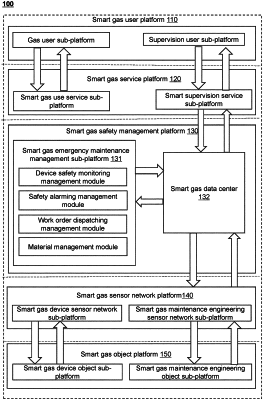| CPC G06Q 10/20 (2013.01) [G06Q 10/06311 (2013.01)] | 8 Claims |

|
1. A management method for maintenance personnel of smart gas, implemented based on a smart gas safety management platform of a management Internet of Things system for maintenance personnel of smart gas, the method comprising:
obtaining maintenance personnel information of at least one maintenance personnel, the maintenance personnel information including first positioning information of each of the at least one maintenance personnel and historical maintenance data of each of the at least one maintenance personnel;
obtaining second positioning information corresponding to at least one maintenance task;
determining a candidate maintenance task based on the first positioning information and the second positioning information; and
sending the candidate maintenance task to a user terminal of the maintenance personnel;
determining a matching score between each of the candidate maintenance task and the maintenance personnel through a task matching model based on a distance between the maintenance personnel and each of the candidate maintenance task, task data of each of the candidate maintenance task, the historical maintenance data, a maintenance cost score of each of the at least one maintenance personnel, and maintenance set data, the task matching model being a machine learning model, wherein
the maintenance cost score is determined through a cost prediction model, the cost prediction model including an embedded layer and a prediction layer; an input of the embedded layer includes the historical maintenance data, and the embedded layer outputs a historical maintenance vector of the maintenance personnel; an input of the prediction layer includes the historical maintenance vector and the task data of the maintenance task, and the prediction layer outputs the maintenance cost score; and the historical maintenance data at least includes feedback information from a customer; and
the maintenance set data includes a number of maintenance personnel required for each of the at least one maintenance task, a number of the matched maintenance personnel for a current maintenance task, and a maintenance cost score of the matched maintenance personnel;
wherein the embedded layer and the prediction layer are obtained through joint training based on training samples with cost labels, wherein the training samples include historical maintenance data of a plurality of sample maintenance personnels and task data of a plurality of historical sample candidate maintenance tasks, and the cost labels include actual maintenance cost scores of the plurality of the sample maintenance personnels, wherein the joint training includes:
inputting the historical maintenance data of the plurality of the sample maintenance personnels into an initial embedded layer to obtain historical maintenance vectors of the plurality of the maintenance personnels, and inputting the historical maintenance vectors of the plurality of the maintenance personnels and the task data of the plurality of historical sample candidate maintenance tasks into an initial prediction layer to obtain cost scores of the plurality of the maintenance personnels;
constructing a loss function based on the cost labels and outputs of the prediction layer;
iteratively updating parameters of the initial embedded layer and the initial prediction layer based on the loss function until a preset condition is satisfied; and
obtaining the embedded layer and the prediction layer;
determining a recommended maintenance task of the maintenance personnel based on the matching score; and
pushing the recommended maintenance task to the user terminal of the maintenance personnel.
|